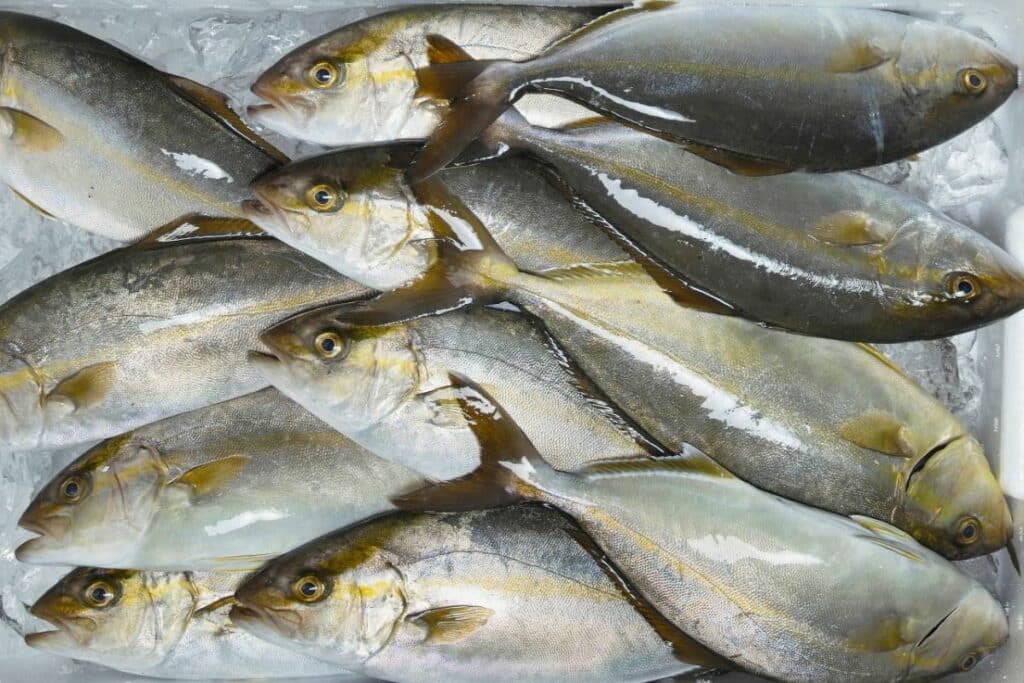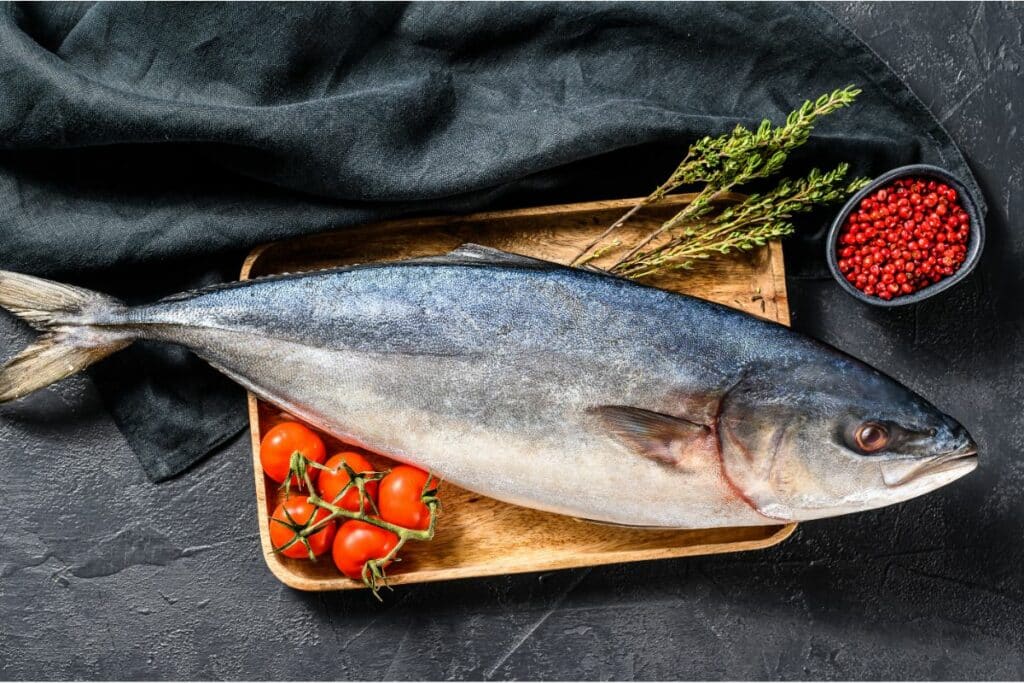Amberjack is a fish that is typically found in the Pacific and Atlantic oceans and is characterized by its predator label and bright colors all over the body. But, what does Amberjack taste like, and can you even eat it?
Well, you can certainly eat amberjack, and most people describe it as tasting a little like mahi-mahi or tuna.
In this guide, I’m going to share a little more about this fish and delve further into its flavor profile.

What is Amberjack?
Let’s start by learning a bit more about this fish, as where a fish comes from can have a big impact on flavor.
If you’re not overly familiar with Amberjack, it is a very colorful fish that typically sports shades of red, blue, gray, white, and even green in some lights.
The color variations can also vary depending on what part of the ocean the Amerback is found in, but these colors are the most common.
Interestingly enough, unlike other types of fish, Amberjack are a species of fish that are known to prey on other types of sea creatures that can be found in both the Pacific and Atlantic waters, including the benthic, bigeye scads, and even smaller fish varieties such as sardines!
Given the fact that Amberjack typically tends to feed on other types of sea creatures to survive, it means that it is a species of fish that is categorized as a predator.
However, despite this label, it is also worth mentioning that the Amberjack is considered to be prey to fishes that are larger than them, as well as sharks and even yellowfin tuna!
On average, female Amberjacks tend to be much larger than males, and this is the case for Amberjacks that are found both in the Pacific and Atlantic oceans.
In addition to this, it is also common for female Amberjacks to have a much longer lifespan than male Amberjacks, but this sometimes isn’t always the case.
What Are The Different Varieties Of Amberjack?
The Amberjack comes in many different varieties; here’s an overview of the most common types:
- Greater Amberjacks: This is the most common type of Amberjack fish, and it is typically found in both the Atlantic and Pacific oceans. The Amberjack is also the largest of all varieties.
- Japanese Amberjacks: The Japanese Amberjack, otherwise known as the Yellowtail, is another type of Amberjack fish typically found in the northwest Pacific Ocean.
- Lesser Amberjack: Despite its name, the Lesser Amberjack is one of the most vicious predators out of all the many different varieties that this fish comes in. It typically has a deeper colorway than some other types of Amberjack fish and larger eyes on average than Greater Amberjacks.
Can You Eat Amberjack?
Yes, Amberjack is perfectly edible.
When prepared properly, amberjack can be a delicious addition to a wide range of dishes.
Its firm texture makes it suitable for grilling, baking, and frying, allowing it to be used in numerous recipes that require the fish to hold up well during cooking.
However, it’s important to note that amberjack is sometimes associated with the risk of ciguatera poisoning, a foodborne illness caused by eating fish that have accumulated naturally occurring toxins. This risk is particularly associated with larger specimens from certain areas.
Therefore, consumers are advised to source their amberjack from reputable suppliers and possibly opt for smaller, younger fish, which are less likely to have accumulated high levels of toxins.
Despite this caution, when sourced and prepared safely, amberjack remains a delightful choice for seafood enthusiasts looking for a flavorful and versatile option.
Amberjack, like many wild-caught fish, can be prone to parasitic infections, including worms. This issue is not unique to amberjack but is a common concern with many types of fish that humans consume.
The presence of parasites in amberjack can vary depending on numerous factors, such as the fish’s habitat, diet, and the water conditions in which it lives.
The most common parasites found in amberjack are nematodes, which are roundworms. These parasites are usually visible to the naked eye and often located in the fish’s muscle tissue.
While the idea of consuming worms can be off-putting, proper cooking methods kill these parasites, making the fish safe to eat.
The U.S. Food and Drug Administration (FDA) recommends cooking fish to an internal temperature of 145°F (62.8°C) to ensure it is safe for consumption.
What Does Amberjack Taste Like?

Now we know a little more about this fish, including that it’s safe to eat, let’s circle back to what Amberjack tastes like.
If you are already a big seafood lover, you might be interested to learn that many people find that the flavor of Amberjack tastes similar to that of both tuna and mahi-mahi!
When cooked correctly, Amberjack has a smooth but slightly tough texture similar to swordfish.
However, Amberjack is much juicier than swordfish and more succulent to bite into.
Although Amberjack is a white fish, its texture is a little tougher than that of other types of fish with white flesh, such as cod.
As for the flavor, Amberjack usually tends to have a refined and mild flavor that can be enjoyed on its own or paired with other ingredients to elevate the flavor profile.
It is also worth noting that the longer Amberjack matures, the more intense the flavor profile will become.
Due to this, if you prefer your fish to have a more powerful flavor, you’ll be making the right choice if you opt for an Amberjack fish that has been given enough time to mature.
All of the Amberjack is edible, but it is widely agreed that the most delicious part of the Amberjack to eat is the loin area, which can be made to create filets and even yummy fish steaks.
Top Tip: If you are planning to try Amberjack for the first time and you’re not sure which variety to try first, we recommend that you choose a relatively small Amberjack. It is widely accepted that smaller Amberjack fish typically tend to have a tastier flavor profile than larger Amberjack fish.
How Is Amberjack Cooked?
As we’re sure you’ll have been able to guess by now, Amberjack is a highly versatile fish – which means that it can be prepared in many different ways!
Traditionally, Amberjack is usually grilled in the oven, which is similar to the way that other types of fish are cooked.
However, it is also common for Amberjack to be made into filets, seasoned with plenty of different spices for enhanced flavor, as well as included in many different recipes to create delicious dishes.
Regardless of the way that it is cooked, due to the subtle and mild flavor of Amberjack, many people feel that it is essential to make sure that Amberjack has been properly seasoned prior to eating, with the most common seasoning being salt, pepper, and olive oil.
When it comes to seasoning Amberjack, though, there truly aren’t any rules, so you can use whatever type of season that you like.
The Bottom Line
So Amberjack is a versatile white fish with a texture akin to swordfish and a flavor similar to tuna or mahi-mahi.
This fish can be enjoyed in a wide variety of dishes and is straightforward to cook.
Frequently Asked Questions
No, amberjack is not a type of tuna; it is a different species of fish known for its firm texture.
Amberjack has a mild taste, not overly fishy, making it popular in various cuisines.
Amberjack is eaten by people worldwide and is appreciated for its versatility in cooking and rich flavor.
Amberjack can be high in mercury, especially in larger individuals, so consumption should be moderated.
Amberjack is considered a healthy fish to eat, providing a good source of protein and omega-3 fatty acids, but its mercury content should be considered.






